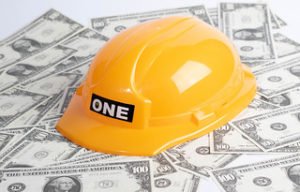construction
If you think safety is expensive… try an accident!
A review of the costs to the construction industry associated with accidents, from Lee Griffiths MSc, CMIOSH.
 “We have all heard it in one form or another, ‘If you think safety is expensive, try an accident!’ This phrase is attributed to Stelios Haji-Ioannou, the ‘Easyjet’ entrepreneur. It was attributed to him when he was a young manager working for his father’s shipping company after a major accident killed five seamen in an explosion on-board an oil tanker in the Mediterranean. It has since been quoted numerous times in various publications espousing the virtues and risks involved in health and safety; however it is quite often left at the quote and nothing more. So how expensive are accidents? How do you quantify the cost of an accident?
“We have all heard it in one form or another, ‘If you think safety is expensive, try an accident!’ This phrase is attributed to Stelios Haji-Ioannou, the ‘Easyjet’ entrepreneur. It was attributed to him when he was a young manager working for his father’s shipping company after a major accident killed five seamen in an explosion on-board an oil tanker in the Mediterranean. It has since been quoted numerous times in various publications espousing the virtues and risks involved in health and safety; however it is quite often left at the quote and nothing more. So how expensive are accidents? How do you quantify the cost of an accident?
“When we think of the costs involved the first point of call is the insurers, how much does it cost them? Risk managers call insurance a transferred risk; meaning that the insurance company accepts the risk and will pay the agreed costs associated with any claim made if the risk is realised. This is deemed an identifiable cost as the cost is covered by an insurance premium and calculated losses paid out by the insurance underwriter. The amount paid out can range from minimal agreed amounts to huge sums. As an example, the average amount claimed for a mild arm injury at work can range from £4,200 to £30,500 (JF Law ltd, 2019). This is not the end of the issue, the pay-outs that insurers make are often strictly limited to the terms and conditions of the policy. There are certain issues that insurers will not pay for which includes any fines and legal costs associated with a criminal prosecution. Losses covered by insurance are usually limited to 3rd party liability and physical losses such as damaged or lost equipment or property. They will not cover the cost of paying sick pay or for temporary employees to be taken on or for profit loss due to delays or ceased production or lost orders.
“It has been suggested that for every £1 compensated for by insurance, £10 is lost from uninsured costs due to injury and ill health caused by work (HSE, 2018).
“So, let’s look at some simple statistics for the construction industry in the UK. First off, the industry accounts for about 7% of the total UK workforce (about 2.282 million workers), contributes to around £113 billion per year to the UK economy and is responsible for around 20% of workplace fatalities in the UK (HSE, 2019). This equates to a fatality rate of 1.64 fatalities per 100,000 workers; four times the national all industry average.”
Conceptualise the risk
“Statistics from HSE show that the total cost of workplace fatalities in 2016 was £200 million and that year there were 142 workplace fatalities in the UK. This equates to £1.408 million per fatality. That year 38 construction workers were killed which equates to 26.76% of the total number. In purely monetary terms this equates to over £53.5 million. However grim and shocking fatalities are they are still rare events so it can be difficult for organisations and individuals to conceptualise the risk of fatal injuries as we always seem to perceive that they ‘happen to someone else, on someone else’s site’.
“But what about non-fatal injuries? It could be argued that, if asked, most people would not have witnessed or been involved in a fatal accident at work. However, if we changed the question to have you seen anyone taken to hospital from work then the answer may well be that most people have seen someone taken to hospital from work.
“With this in mind let’s look at the statistics for injuries alone. Estimates from the Labour Force Survey in 2017-18 identify over 555,000 people who sustained injuries at work. From this number, over 135,000 people required at least seven days off work. In the same period there were 58,000 non-fatal injuries to construction workers (LFS, 2018). This equates to a rate of around 2,620 injured people per 100,000 workers. This is 50% higher than the national average for all industries. The estimated cost of all injuries in the construction sector (fatal and non-fatal) is around £490 million per year (HSE 2018). In that year there were 30 fatalities in the construction industry. Assuming the cost per fatality has remained the same this equates to £44.4 million; leaving the costs for non-fatal injures running at £445.6 Million or £7,682 per injury. But hold on, most of the injuries we see are minor cuts and bruises! How can this be correct?? Well first off these are averages, secondly they look as the costs to society as a whole not just to the industry. As an example, in 2002 it cost around £33.00 (HSC 2002) for a first aider to give another worker first aid only and then to fill out the relevant paperwork (first aider lost time etc.). The Department of Health states that as of 2018 it costs around £7.00 per call to 999, £233.00 for an ambulance to take a person to A&E, over £140.00 for an A&E assessment and £400.00 per day for a hospital bed without treatment, costs of treating a minor wound or sprain to the NHS is around £680.00. As you can see these costs are adding up and this has not yet looked at the costs to the business or the individual.
“The construction employers’ liability claim index provided by the JLT group in 2017 noted that insurance premiums would go up globally as a result of huge liability claims from disasters such as Hurricane Irma. This has caused the insurance industry to harden with fewer insurers available meaning that premiums and negotiating rates would be much harder in the event of a claim. They further noted that the average cost of all claims (above £1000.00) was £31,000 up 2.5% on the previous year. It also noted a large increase in the number of claims in excess of £1m from four in the previous year to nine in 2017. These are known as catastrophic claims and would in all likelihood lead to a withdrawal of further cover beyond the original date. This could in itself cause firms to either cease trading completely due to the inability to find insurance or to drastically reduce the scope of work and services they provide ultimately impacting financial bottom lines.
“The human cost is harder to gauge however in purely financial terms the HSE’s Costs to Britain model notes that 57% of the total cost of accidents or ill health caused by work is born by the individual.”
Reporting of accidents
“The nature of modern construction projects in the UK at the moment rely heavily on low skilled migratory and transient labour forces. These people are often the most vulnerable to financial hardship and are also the most likely to be seriously injured or killed. A study commissioned by HSE back in 2006 claimed that migratory workers where indeed more likely to be injured in a workplace accident than others and that there was also a higher rate or under reporting of accidents in general due to worker fear of losing their job as a result of an accident. It should be noted that it is difficult to predict the effect on accident statistics that Brexit and new rules on migrant workers will bring.
 “The negative effect of public opinion can put serious financial strain on a company even if a company is not at fault but associated by its supply chain or contractors. After the 2013 Dhaka factory collapse, Primark’s flagship store on Oxford Street in the UK was surrounded by protestors who saw the clothing retail chain as having some form of responsibility for the accident as they had clothing manufactured there. Primark went on to pay over $12m in compensation to the victims fund (The Guardian 2014). To put this into context; that was enough to pay for a high-end health and safety manager to be employed in every Primark store (257 stores in 2014) in UK and Europe for a year. Other companies associated with the factory also suffered. The fashion retailer Benetton took less than 2% of the output of the factory and still ended up paying over $1m into the compensation fund (The FT 2015).
“The negative effect of public opinion can put serious financial strain on a company even if a company is not at fault but associated by its supply chain or contractors. After the 2013 Dhaka factory collapse, Primark’s flagship store on Oxford Street in the UK was surrounded by protestors who saw the clothing retail chain as having some form of responsibility for the accident as they had clothing manufactured there. Primark went on to pay over $12m in compensation to the victims fund (The Guardian 2014). To put this into context; that was enough to pay for a high-end health and safety manager to be employed in every Primark store (257 stores in 2014) in UK and Europe for a year. Other companies associated with the factory also suffered. The fashion retailer Benetton took less than 2% of the output of the factory and still ended up paying over $1m into the compensation fund (The FT 2015).
“Stock market loses due to negative public opinion are usually temporary and stocks do tend to rebound and recover from this. However, these temporary loses can be huge. After a passenger was filmed being dragged off a United Express Airlines in 2017 stock prices in the parent company United Continental Holdings dropped by 4%at one point which equated to around an £800m loss in share value (BBC 2017). The stock rebounded and recovered after a few days but United settled out of court with the passenger for an undisclosed sum.
“So, after looking at all this there does seem to be some serious merit in Mr Haji-Ioannou’s statement.”
If you think safety is expensive… try an accident!
A review of the costs to the construction industry associated with accidents.
Safety & Health Practitioner
SHP - Health and Safety News, Legislation, PPE, CPD and Resources Related Topics
New cladding fire risk identified and could be “tip of iceberg”
Company fined £450k and director and site manager sentenced following death of labourer
Huge step towards inclusive PPE as industry body promises to ensure provision

 “We have all heard it in one form or another, ‘
“We have all heard it in one form or another, ‘ “The negative effect of public opinion can put serious financial strain on a company even if a company is not at fault but associated by its supply chain or contractors. After the
“The negative effect of public opinion can put serious financial strain on a company even if a company is not at fault but associated by its supply chain or contractors. After the